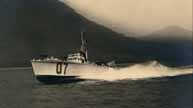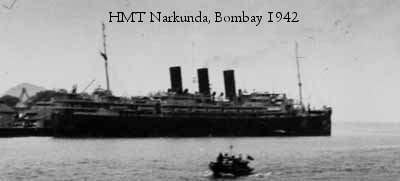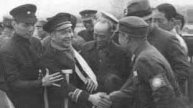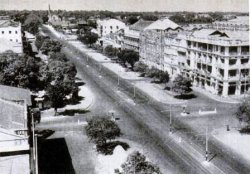Thank you all for your contributions, may our forefathers be remembered.
14th February 1942 (Sat)
Lt Kennedy RNVR "As we passed through the many small stations, the saffron robes of the Buddhist priests stood out against the dusty background." [9]
The party disembarked from the train to find the station in total chaos. Outside was no better, the square in front was a seething mass of bodies and noise. Once on the road they were struck by a stark contrast, the once bustling city was silent, there were no vehicles, no people. The city was dead, just an eerie silence as they were driven to their accommodation, officers in the stiflingly hot Minto Mansions hotel on the corner of Halpin Road & LeedsStreet, , ratings in the Mayo Masin Club.
They had endured fifty one grueling days on the road since escaping from Hong Kong.
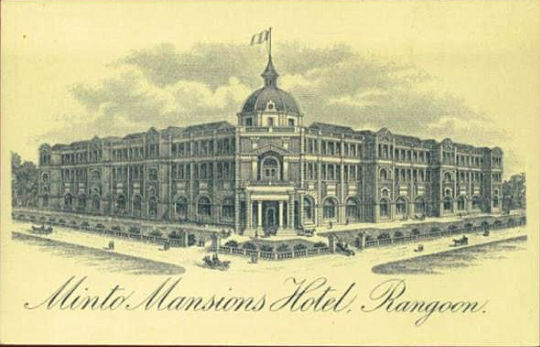 Lt Kennedy RNVR "We were met by a British Army Officer, Captain Cowie, from Glasgow. We found the station square outside packed with Indians clamouring to leave, and we were greeted with the astonishing news that Singapore had fallen.
Lt Kennedy RNVR "We were met by a British Army Officer, Captain Cowie, from Glasgow. We found the station square outside packed with Indians clamouring to leave, and we were greeted with the astonishing news that Singapore had fallen.
The three thousand mile journey we had started fifty-one days before was over, but somehow the satisfaction of having at last completed it had evaporated in the depressing atmosphere of Rangoon." [9]
L/S Les Barker "Arrived at Rangoon at 1.30 pm and were taken to the Mayo Masin club where we were to stay. Spent the day looking over Rangoon. Not many people present. Mostly evacuated. Very dead at night." [24]
Ships Log "Arrived Rangoon to discover that orders had been sent to Lashio one week before and never arrived. Had party arrived Rangoon 3 days earlier would have been put straight aboard Enterprise for Colombo. Orders to be retained arrived from C-in-C." [5]
Eve Curie, Author & Journo “The station was one large bottleneck - and, as I was quickly to find out, the liveliest spot in town. Indian, Burmese, and Chinese refugees, crowds of them, were lying on the platform or sitting wearily on their bulky, shabby bundles, like flocks of frightened animals.
There were no taxis in sight; the whole transportation system in Rangoon had already collapsed completely. It was an incredible piece of luck that two different cars should be waiting for me. Again I recognized the emptiness, the unforgettable silence of large cities in danger. I smelled at once this ghastly odour of defeat, of retreat, of fear, that I knew only too well, that was attached forever to the Europe of 1940 and had obsessed me ever since the fall of France.” [14b]
Lt Kennedy RNVR "As we forced our way through the crowds and drove along empty streets one thing was obvious. Rangoon was dying. The same air of decay which hung over the city pervaded the hotel, as unassisted we humped our luggage into an unswept hall. The proprietor was profuse in his apologies and told us a long tale of woe about his boys who had nearly all ran away. The three thousand mile journey which we had started fifty-one days before was over, but somehow the satisfaction of having at last completed it had evaporated in the depressing atmosphere of Rangoon." [9]
Eve Curie, Author & Journo "The only hotel that had not yet closed altogether was called the Minto Mansions. In its torrid hall, half a dozen English officers were gloomily reading the papers. They cast a startled look in my direction when I came in with my bags and asked for a room. I learned from the manager that his terrified Burmese and Indian servants were fleeing one after another." [14b]
Lt Kennedy RNVR "The same air of decay which hung over the city pervaded the hotel, as unassisted we humped our luggage into an unswept hall. The proprietor was profuse in his apologies and told us a long tale of woe about his boys who had nearly all ran away. The three thousand mile journey which we had started fifty-one days before was over, but somehow the satisfaction of having at last completed it had evaporated in the depressing atmosphere of Rangoon." [9]
PO Buddy Hide "Rangoon was deserted and we were there five weeks, loading merchant ships, special guards, stopping looters, and numerous other jobs ." [21]
Lt Collingwood RN "Commodore Cosmo Graham was flown in from the Persian Gulf to take over the Burma Coast Command." [8]
Lt Kennedy RNVR "Gandy had gone to report to the Senior Naval Officer, a Commodore who had just flown out from the Persian Gulf to take over the Burma Coast command, and we could expect new orders at any time." [9]
Fifty six year old Rear Admiral Cosmo M Graham had just hoisted his pennant at the Navy HQ after flying in from the Persian Gulf to take over as Commodore Burma Coast Command. Gandy gave a brief account of his escape from Hong Kong, before placing the Ship’s Company of the late 2nd MTB Flotilla at the Commodore’s disposal. His orders were to rest the ships company for the day and report back the following day.
Eve Curie, Author & Journo "I managed to get a glimpse of the city while driving in it at full speed from one place to another. The residential and commercial sections of Rangoon were practically untouched. The Japanese had been hammering chiefly at the Mingalodon air base and had bombed the town just enough to spread panic among the native population.
I witnessed from hour to hour how a large town stricken by fear can go to pieces, just as an individual can have a nervous breakdown. It was already a dead city, as good as lost. It was a body struck with pernicious anemia." [14b]
Lt Kennedy RNVR "As police control had collapsed and the jail doors and asylum gates were open, it was not healthy to go about unarmed and we set off in search of an evening meal, a villainous, bearded band with heavy .45 revolvers strapped to our sides.
The Silver Grill, the only restaurant functioning, was a wild place that night. And in this Wild West atmosphere we celebrated our return to civilization." [9]
15 - 17th February 1942 (Sun-Thurs)
Gandy along with his senior officers reported back to Navy HQ for orders. Lt's Collingwood & Kennedy were retained for staff duties. A/B Barker was enlisted as the Commodore's driver. Lt Ashby was retained as SNO port duty, while Gandy was assigned to complete a feasibility study on a special mission to Bassein, now Pathein ninety five miles west of Rangoon.
Lt Collingwood RN "The Commodore needed a staff officer and a driver so he asked me to join him." [8]
Ships Log "At Rangoon. Officers in the Minto Mansions [hotel] ratings at Mayo Masin Club, later transferred to Burma Navy depot.
Lt's Collingwood & Kennedy retained for duty at naval headquarters." [5]
A/B Lenny Rann "Unfortunately we had no mosquito nets, with the result we were nearly bitten to death." [63]
Lt Kennedy RNVR “The Minto Mansions struggled to keep going during the next week, and Mlle Eve Curie who had just come out from reporting in Russia stayed for a few days before going on into China.
There were no buses or taxis running, but the transport problem was easily overcome, for hundreds of jeeps lay in a dump not far away, and we simply helped ourselves. Eventually most of these vehicles which were originally destined for China had to be burned along with other war material before the city was abandoned” [9]
Alan Warren, Author "Dogs howled in the distance, vandals and looters roamed the streets. By this time Rangoon was a dead city." [98]
George Rodger, Photo Journalist "The criminal and crazy ranged the city, looting whatever they could carry and burning what they could not.
Strangely, I found that the British were still in control. The light, power and water services were still working. Armed Indian Army guards still stood outside the water transport offices." [97]
17 - 19 th February 1942 (Tues)
Ships Log "V2 (Lt-Cmd Gandy) went on special mission to Bassein." [5]
Gandy, a former land surveyoy in Hong Kong proceed to the river-port of Bassein. His brief was to assess the feasibility of the port for use and subsequent defence. The IJA bombed the runway while he was inspecting the airfield with officers and officials of the Bassein Defence Advisory Committee.
Maj-Gen S. Woodburn Kirby " A survey of Bassein was undertaken. It showed that a year would be needed to develope it sufficiently to accomodate nine oceon-going steamers, and that even to construct a wharf for three ships would take six months" [96]
A/B Lenny Rann "We were moved to the Burma Royal Naval Volunteer Reserve Depot, where we were provided with tropical kit." [63]
The party were in Rangoon for five weeks loading merchant ships, while some of the flotilla were deployed to man motor launches due to Burmese desertions, as well as doing special duties, which included stopping looters.
The ratings were billeted in the Burma Royal Navy Reserve Depot where tropical kit was issued. [66]
L/S Les Barker "Moved to Burmese Naval Barracks. "Detailed to be the Commodores bodyguard and moved under canvas. Large fires breaking out at night." [24]
In January 1942 men of the Royal Marine Coastal Regiment in Ceylon volunteered for a mission of a hazardous nature known as Force Viper.
Five officers and 102 NCO's and Marines arrived in Rangoon under Major D Johnson RM to protect the docks and oil refineries.
V-Force took over motor launch patrols using a variety of speed-boats and four requisitioned tourist launches to protect the outer flanks from Japanese insurgents infiltrating the inland waterways.
Certain members of the escape party, including Lt Ashby, Sub-Lt Brewer and Petty Officer Buddy Hide volunteered to assist the Royal Marine Commando.
Eve Curie, Author & Journo "I did see the transport and cargo ships crowding the jetties, some of them empty, others still full of valuable war weapons that the Allies would never use. The greatest bulk of these crates, which had come all the way from the United States and England, was finally to be burned on these very docks by the retreating Allies." [14b]
Lt Kennedy RNVR "When the hotel finally closed we moved into a private house which was being used as a naval mess, and a few faithful servants managed to give us meals of a sort." [9]
20th February 1942 (Fri)
Back in Chungking David MacDougall was making plans to return to London
David MacDougall MoI "I refused good offers to stay in China, and in Calcutta because I wanted to see how the land lay at home. But I want my freedom of action just for the moment. The Ambassador is being transferred to Moscow, but he is very anxious for me to stay on in Chungking on my own terms.
My own ideas are to get transferred temporarily to London and then re-assigned in due course to one of the W. Indian colonies. I could get a very large salary here – but I feel I want a change." [26]
Lt Kennedy RNVR "The order came through from GHQ to stand by for final evacuation. At the naval offices files and papers were being burnt.
The civil evacuation officially started and the last of the European women sent north to Mandalay and Mamyo." [9]
Orders were posted on walls and trees stating all non essential vehicles were to be immobilized/destroyed. All essential vehicles were to display a large "E" on the windscreen.
Ships Log "Told to standby for evacuation of Naval HQ." [5]
The Commodore transferred his flag to the 'SS Heinrich Jessen' from the shore based HQ. The Jessen was now let to the "China Navigation Company" for war duty from Butterfield & Swire, Hong Kong, George Rhod Hansen, the Master received an extra GBP 5.00 war risk bonus.
The officers and ratings of the Hong Kong escape party were ordered to repair on board the Heinrich Jessen.
As well as her standard ante-aircraft armament, extra Bren and Lewis machine-guns were mounted and trained on the wharf due to the looting taking place amidst theincreasing chaos.
A crate of spirits had been looted, resulting in many drunk and disorderly men frequenting the docks. [21]
Lt Kennedy RNVR "Near the docks it was a fight to force a way through the panic-strican crowds, and every time the air raid alarm there was practically a riot." [9]
"The docks were in a state which it was hardly believable could have existed in any British possession.
The crews of the ships alongside, and the troops, had looted cases of liquor." [98]
21st February 1942 (Sat)
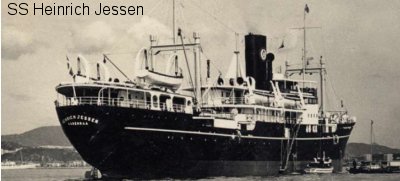
"All seaworthy motor-launches and local naval defence vessels were ordered to proceed to Akyab for the protection of that port and its airfield from sea borne attack.
Two Motor Launches and six mine sweepers to be towed to Calcutta. All other vessels not in use to be scuttled " [96]
Ships Log "One CPO, one SPO, and one L/Seaman left for Calcutta assisting with mine-sweepers in tow.
Ten ratings drafted for duties in ML's.
Six Tel's handed over to Lt-Cmd Dinkly
Twelve ratings detailed for HQ guard. (One rating in hospital." [A/B Penny ?] [5]
Ten of the MTB ratings were drafted to assist the Burma RNVR who, with both British and Burmese officers, had just five ML's and a few auxiliary vessels left. Most of the Burmese officers and ratings had deserted.[9]
Lt Kennedy RNVR "Along with two old ship-mates, Petty Officer Dyer and Able-seaman Downey, I was sent to join His Majesty's Burmese minesweeper 'Somagyi', and we drove to the docks in a jeep piled high with gear, Rangoon looked even more desolate than ever. We were witnessing the complete disintegration of civil order, and it was a sad and ugly site.
HMBS Somagyi was one of three Port of Rangoon tugs and buoy vessels converted for mine sweeping duties when the Burma RNVR was mobilised in June 1940.
A/B Lenny Rann "The evacuation of Rangoon commenced and I was drafted to an M.L. and went on patrol duties for a week." [66]
Admiral Chan Chak departed Shaoguan and proceeded to Guilin via Hengyang where he was greeted with a hero's welcom. Chan stayed here for a week and a half recuperating before flying on th Chungking. [6]
Lt Kennedy RNVR "In the late afternoon we sailed from Rangoon in company with the ML's and other small vessels. Once out of the river the 'Somagyi' started to roll, and what a roll, a roll which persisted even in the slightest sea, and being coal-fired our speed was dependent almost entirely on how sea-sick the Burmese stokers were feeling.
The coarse was set for Diamond Island lying off the south-west corner of Burma near the mouth of the River Bassein." [9]
22nd February 1942 (Sun)
Ships Log "18.00 party proceeded aboard 'Heinrich Jessen. Some officers and ratings used for loading HQ office gear, cars, baggage etc. Working all night and flotilla mainly loading general cargo, airplanes etc." [5]
Lt Kennedy RNVR "From an anchorage under the lee of this typical desert island, our mixed flotilla operated during the next week." [9]
23rd February 1942 (Mon)
Ships Log "12.00 Sailed, destination uncertain." [5]
L/S Les Barker "Cast off at 12 noon for an unknown destination. Rangoon well ablaze by looters and fifth columnists. Too much looting going on in the wharfs." [24]
Lt Kennedy RNVR "The wireless station on the island had to be demolished, and an ML was sent to the Alguada Reef to take off the lighthouse keepers and destroy the light." [9]
24th February 1942 (Tues)
L/S Les Barker "Still under-way. My birthday today, 22 (Four years today since I left England). Anchored off Richmond Island for a while, then ordered to return to Rangoon." [24]
Ships Log "At sea. Received orders to return to Rangoon as signal not proper procedure, ran into Diamond Island at mouth of Basein River and sent signal. Weighed for Rangoon." [5]
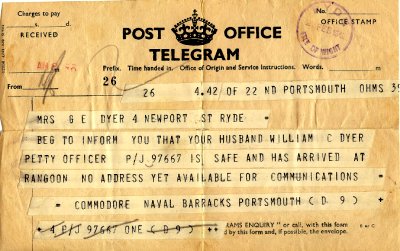
Telegrams were sent out informing the families that the Royal Navy members of the escape party had arrived safely in Rangoon
Gandy concluded that Bassein could not be defended with the limited resources available. With the airfield now out of commission, he had no alternative but to send a signal requesting a sea passage back to Rangoon, a river and sea journey of two hundred and forty five nautical miles.
Lt-Cmd Gandy RN (Ret) “A few bombs fell in the native town causing panic and a few fires. I saw no ambulance, no regular fire engine, only a solitary old Burmese driving an iron-wheeled, steam driven, incredibly Victorian machine with a pump. He drove it slowly backwards up to a burning store so that he could always go forwards for a quick getaway. But he had no hoses and no assistants; he was just an old man with a sense of duty and a useless machine.” [80b]
Lt Kennedy RNVR "We received news that the town of Bassein had been bombed and the 'Somagyi' was ordered up the river to evacuate some Europeans, and if possible take on provisions and coal at the same time. It was a tricky passage up eighty miles of winding river, but with the aid of a wizened little native pilot who gave his helm orders on the bridge by a wave of the hand, it was safely accomplished. " [9]
The railway systen in southern Burma collapsed due to desertions. [96]
25th February 1942 (Wed)
Ships Log "Arrived Rangoon to find entire convoy returned. Remained at ten minutes notice for sea." [5]
A/B Les Barker "Arrived back at Rangoon and went to live in Mayo Masin Club again which we had to ourselves, not a soul around." [24]
Railways in southern Burma taken over by the military. [96]
26th February 1942 (Thurs)
George Rodger, Photo Journalist As night fell, the sky lit up with fires. The lunatic Burmese, led by the convicts, were setting fire to houses of the well-to-do and the Hindu labourers who did the work of Rangoon. Nobody was caught. British officers shot a few of the Burmese but there was nobody to remove the bodies, because under the Buddhism of Burma, burial is a privilege reserved to certain religious groups.
The smell of death and charred wood weighted the air of Rangoon.
Ships at the dock were still unloading trucks and supplies to rush up the Burma Road, though somebody had already destroyed a great depot of American lease lend materials. [97]
L/S Les Barker "Fires blazing every night here. Bodies pretty frequent on the roads. Fired upon during the night. Rangoon is in a very bad state now." [24]
Lt Ashby HKRNVR "The British forces remaining in Rangoon after the Administration went traded a number of trucks and cars assembled at the docks for cigarettes and rifles. Everybody had a car, but finally had to smash them." [5]
Ships Log "Received orders to load other ships of convoy which then proceeded.
Worked all night placing depth charges under cranes on wharf ready for demolition. Rangoon almost completely deserted. Fires being lighted by the Burmese all over the city during the night. Burmese cutting up Indians on every opportunity.
Looting general - several good shoot-up's." [5]
Lt Kennedy RNVR "The Burmese had no love for the Indians who had a big share of the business interests in the capital. Now, when law and order was crumbling, was their opportunity to retaliate.
These bands of Burmese who roamed the streets armed with dahs also looted the many lovely European houses which lay empty and unprotected." [9]
27th February 1942 (Fri)
Ships Log "Under new sailing orders. Arrangements for demolition completed. MTB personnel re-embarked in Jessen." [5]
Lt Kennedy RNVR "The docks were bereft of native labour and there was no one to control the hundreds of destitute Indians who swarmed about restlessly in the streets outside in the hope of getting a passage out of Burma." [9]
L/S Les Barker "Ordered to embark on Heinrich Jessen again. " [24]
Lt Ashby HKRNVR "The city was practically deserted. When we wanted to eat meat, we went to the zoo and shot deer. " [5]
Lt Kennedy RNVR "The potentialities of the local zoo had not been overlooked, and a few enterprising sailors armed with .45 revolvers had paid it a visit in search of buck." [9]
28th February 1942 (Sat)
The "W" (warning) notice was posted on walls and trees stating that all non essential people and last ditchers, the volunteer civilians assisting the scorched earth policy, were to leave immediately
Ships Log "Ready to sail all day, then sailing cancelled." [5]
Alec Damsgaard, who had been shot in the leg and abandoned on board the Cornflower launch in Aberdeen Channel arrived in Shanghai in the early hours after being released from hospital in Hong Kong. He had left Hong Kong by steamer with Herr Heisterberg, a fellow Dane, for the three day passage.
1st March 1942 (Sun)
During the month of March The heat increases rapidly by the day.
Ships Log "Orders received to sail - destroyed all gangways on wharf. Sailed for Akyab. Anchored at mouth of river. No air raid - demolition set.
18.00 Orders received from General Wavell canceling evacuation. All ships of convoy returned to Rangoon." [5]
L/S Les Barker "Proceeded down river and anchored off ‘Dry Tree Point." [24]
David MacDougall arrived in Lagos, Nigeria after a nine day journey by air from Chungking via Calcutta. David stayed at the Chief Secretary Alexander Grantham's home before flying on to London. Grantham would later join Mac back in Hong Kong in July 1947. [26]
2nd March 1942 (Mon)
Ships Log "Arrived back in Rangoon. Discovered the reason for our return was that we had to get in and unload two more convoys in double-quick time. Wharf's cleared of rubbish and demolition charges, ready for arrival of convoy." [5]
David MacDougall MoI "I may be here (Lagos) for a week more but my bags are kept packed for instant departure whenever the chance occurs. They only give you about an hour’s notice.
I left Chungking on the 20th Feb. and arrived here yesterday, having come more than half way round the world. Exhausting but interesting. My wound is almost healed and is going on nicely.
I refused good offers to stay in China, and in Calcutta because I wanted to see how the land lay at home.
And Grantham wanted to wire the C.O. to retain me here in Nigeria where they are short of staff. But I want my freedom of action just for the moment. " [26]
3rd March 1942 (Tues)
Ships Log "1st convoy in, working day and night unloading ships and loading." [5]
Lt Kennedy RNVR "When the convoy bringing the armoured brigade arrived all hands worked day and night to unload the tanks and vehicles." [9]
L/S Les Barker "In Rangoon loading lead." [24]
4th March 1942 (Wed)
L/S Les Barker "Loading lead." [24]
Ships Log "Jap's reported crossing Rangoon River. Two ML's to investigate" [5]
5th March 1942 (Thurs)
L/S Les Barker "Loading lead." [24]
Ships Log "Loading fuel oil into Jessen and working unloading 2nd convoy.
ML1103 captured sampan with Jap officer and fifty Burmese in Rangoon river. Five more sampans escaped." [5]
Lt Kennedy RNVR "Two ML's had a sharp encounter with enemy launches close inshore and had managed to pick up a Japanese prisoner, and he was transferred to the Jessen before we sailed for Akyab." [9]
PO Buddy Hide "We caught 50 Burmese with a Japanese officer trying to land, they were all shot." [21]
6th March 1942 (Fri)
"The C-in-C Major Alexander declared that Rangoon could no longer be held and implemented the evacuation procedures." [96]
L/S Les Barker "Loading lead." [24]
Ships Log "All day work on convoys. Jap's over and near Rangoon. Position again very serious.
Decided to instigate river night patrol in launches. Four officers Ashby - Brewer - Wyne, & ???. Patrolled all night - frequently machine-gunned by our own troops. No casualties which was amazing." [5]
Admiral Chan Chak left Guilin and flew to Chungking where he had the 'Medal of the Victorious Garrison' bestowed upon him. Chan was lauded world wide with headlines of "Allied Military Commander", "China's Nelson" and "World Hero" [6]
Previous...............Next
HTML5 requires a recent, fully-updated web browser. If you experience any problems, you need to update your browser.
Research and web publication by Buddy Hide Jnr ©
The contents of this web site led to a considerable number of escapee families contacting me and now each other, and remains the principle source of contact and private information for the spin off projects that have followed. The personal accounts enabled me to record the complete and true account of this remarkable episode of Sino-British war time co-operation. The information compiled here has directly resulted in a museum exhibition in Hong Kong, a re-enactment of the escape in Hong Kong and China, with a movie drama and documentary in the making.
Contact | Mwadui | Guest Book | Top | © MCMXCVI Hamstat Integrated Systems | Escape from Hong Kong
Site maintained by Hamstat Integrated Systems Inc
© Hong Kong Escape.org 2019
